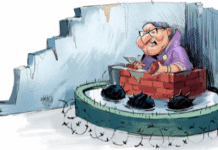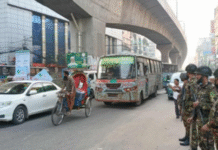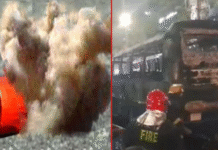Bangladeshi firefighters and volunteers work to put out a fire at the Ashulia industrial district on the outskirts of Dhaka.
A fire erupted at a garment factory on the outskirts of Dhaka on Thursday morning, sending employees fleeing in terror and raising more questions about safety conditions in Bangladesh less than two months after the collapse of the Rana Plaza factory building claimed more than 1,100 lives.
Bangladesh is the world’s second leading clothing exporter, after China, and Thursday’s fire again exposed the dangers facing workers in many factories making clothes for consumers in the United States and Europe.
The blaze erupted in the Ashulia industrial district, on the northern tier of Dhaka, at about 9:30 a.m. on the ground floor of a company that labor activists and other witnesses identified as Arva Textile Limited, although some Bangladesh news agencies spelled the name as Arba. Black smoke poured out of the windows as some workers were injured while rushing to escape. No fatalities were reported and firefighters doused the flames within about two hours.
Labor activists who rushed to the burning factory said they had found clothing labels for Dickies, the name brand of the Williamson-Dickie Manufacturing Company, a storied American business that describes itself as the world’s largest work-wear manufacturer.
Williamson-Dickie said in an emailed statement that its European affiliate had halted business with Arva in February, and that its records indicated no association with the other company in the burned building, Hasmatullah Knitwear.
The statement did not explain why business with Arva had been stopped, but that Williamson-Dickie “maintains a strict Code of Conduct and social compliance program to which all business affiliates must adhere — including global Williamson-Dickie offices, distributors, contractors, sourcing offices and licensees.”
Abdul Hamid, a senior fire official, said the cause of the blaze was not yet determined. But it erupted in an enclosed, ground-floor room where fabric was stored in the six-story building. Arva Textile rented the first three floors of the building and Hasmatullah Knitwear rented the upper three floors.
“The fire did not spread to other floors of the building as it was a locked warehouse,” Officer Hamid said, noting that firefighters had to break through a wall in order to douse the flames in the storage area.
There were conflicting reports on whether Arva Textile had adequate firefighting equipment. Fire officials told Bangladeshi media outlets that the factory lacked proper fire extinguishers and other things. However, Officer Hamid said he thought the factory had an appropriate fire safety license.
Brig. Gen. Ali Ahmed Khan, director general of Bangladesh’s Fire Service, said both factories in the building had been recently granted conditional fire safety licenses through next month. He said inspectors had found shortcomings, notably a lack of on-site water resources in case of fire – a problem that had not been rectified by Thursday. Firefighters were forced to import water from other areas, causing delays in extinguishing the blaze.
“If these factories do not improve their shortcomings within a month, we won’t renew their fire licenses,” he said.
Mohammed Obaidullah, owner of the upstairs knitwear factory, said his workers were able to escape by filing down two staircases that did not pass through the ground-floor storage area. He said his factory had been audited, passing compliance standards, and produces jackets for a European brand marketing in Germany, Turkey and Britain.
International labor rights groups say that hundreds of workers have died in fires in Bangladeshi factories during the past decade. Last November, a fire erupted at the Tazreen Fashions factory, killing 112 people, as workers were making items for Walmart, Sears and other retailers. In that incident, the blaze also began on the ground floor, where the owners had illegally stored huge mounds of fabric without enclosing them in fireproof walls.
As was the case on Thursday, factories often share the same building. Five factories were inside the Rana Plaza building when it collapsed in April, killing 1,129 people, in what is considered the deadliest disaster in the history of the garment industry. Rana Plaza had been shoddily built, atop filled wetlands, yet workers had been ordered inside even after an engineer had examined cracks in the structure and warned the building was unsafe.










